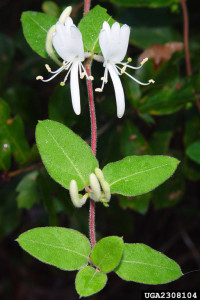Go anywhere in the woods of the East, you are likely to see Japanese or shrub honeysuckles, multiflora rose, privets, Japanese stiltgrass, garlic mustard, Chinese tallowtree, … .
Japanese honeysuckle; Chuck Bargeron; Bugwood.org
A new study confirms how widespread these invasive plants are.
Christopher Oswalt and colleagues (2016) have studied the data from the national Forest Inventory and Analysis (FIA) program of the United States Forest Service. They found that almost 40% of forests in the United States are invaded by alien plant species. Furthermore, forests in the eastern United States have been invaded by more invasive plant species than those in the West.
Large numbers of invasive plants are established in the United States. As I noted in this blog in January, nearly 10,000 non-native plant species are present, although not all are invasive. (See Rod Randall’s report here ).
The USDA Forest Service develops region-specific lists in consultation with invasive plant experts. Then the authors normalized the data by calculating the proportion of forested subplots in each county with at least one invasive species present. Oswalt and colleagues then used this percentage to define invasion intensity for those plots that contain any invasive plants on the region or state-specific monitoring lists. They mapped the subcontinental spatial distribution of invasive plants based on this measure of “invasion intensity”.
Nationwide, 39% of forested plots sampled contained at least one invasive species. There are significant regional differences. To no-one’s surprise, Hawai`i had the highest invasion intensity – 70%. Second highest density is in the eastern forests – 46%. Forests in the West ranked third, with 11% of plots containing at least one of the monitored invasive plant species. Finally, forests in Alaska and the Intermountain regions both had 6% of plots invaded. This finding might surprise some because of the level of political attention given to plant invaders on grazing lands in the West.
The authors attributed clusters of more highly invaded counties to disturbance, e.g., fragmentation in the North Central region and major travel corridors in the Piedmont of the Southeast.
I would rephrase the principal cause as “propagule pressure”. While forests of the East are certainly small and surrounded by other land uses – that is, fragmented – these are also areas where invasive plants have been extensively planted – some for nearly a century. Some – e.g., honeysuckles, multiflora rose, and lespedeza – were intentionally planted in woodlots as food or cover for wildlife.
Another factor is the great diversity of invasive plant species present in the East and thus available to spread into the forest by such mechanisms as transport of seed by birds and other wildlife. The Southeast Exotic Pest Plant Council maintains a list of approximately 400 invasive species. The Mid-Atlantic Invasive Plant Council has a list of 285 invasive plants. Many of the invaders in both lists are herbs, shrubs, or trees which can invade shaded environments.
The top five most frequently detected invasive plants in the Southeast were Japanese honeysuckle, privets, roses, lespedeza, and microstigium. The first four have been deliberately planted either directly in “natural” areas or in yards and gardens throughout the region. The top five species for the Northeast and Midwest are multiflora rose, reed canary grass, garlic mustard, Japanese honeysuckle, and common buckthorn. Again, four of these have been widely planted deliberately. Note that few of these species’ seeds are spread by wind.
In contrast, the top five species in the Intermountain West are less frequently planted intentionally: cheat grass, Canada thistle, spotted knapweed, houndstongue, and musk thistle. Invasive plants in forests of the Pacific states fall between these poles, as they include planted species, such as Armenian blackberry, and unplanted ones, such as cheat grass and medusahead.
Clearly the threat from invasive plants is great and growing (see my blogs from January for discussions of other aspects of the problem). What should we do to counter it?
• Those who sell plants for any use – ornamental horticulture, ground cover, livestock forage, soil amelioration, wildlife habitat management, biofuels – should commit to avoiding species that are known or suspected to be invasive in the region.
• Voluntary efforts to limit sales of invasive plants have fallen by the wayside. The various Invasive Plant Councils should work with industry groups and others to renew this effort. Also, the Councils should propose a joint list of additional plants for APHIS regulation under NAPPRA (see below).
• Those who buy plants for these various uses should make a similar commitment – especially large, institutional buyers like state highway departments.
• Concerned citizens should lobby their state governments and the Congress to fund ongoing “noxious weed” programs and to ensure that these programs include plant species that threaten natural areas, not just weeds of agriculture.
• Concerned citizens should lobby the Congress to increase funding for federal agencies’ invasive plant control programs, especially those addressing natural areas, and especially in Hawai’i and the eastern United States. Also, the U.S. Department of Agriculture needs to adopt procedures that enable APHIS to act more quickly to curtail introduction and human-assisted spread of invasive plants. Most urgently, APHIS should finalize the May 2013 proposal to restrict importation of 22 species under the NAPPRA program (see my blog “Invasive plants – huge numbers! Continuing spread …” from January and the description of the NAPPRA program here).
Source
Christopher M. Oswalt, Songlin Fei, Qinfeng Guo, Basil V. Iannone III, Sonja N. Oswalt, Bryan C. Pijanowski, Kevin M. Potter 2916. A subcontinental view of forest plant invasions. NeoBiota. 24: 49-54 http://www.srs.fs.usda.gov/pubs/48489
Posted by Faith Campbell
